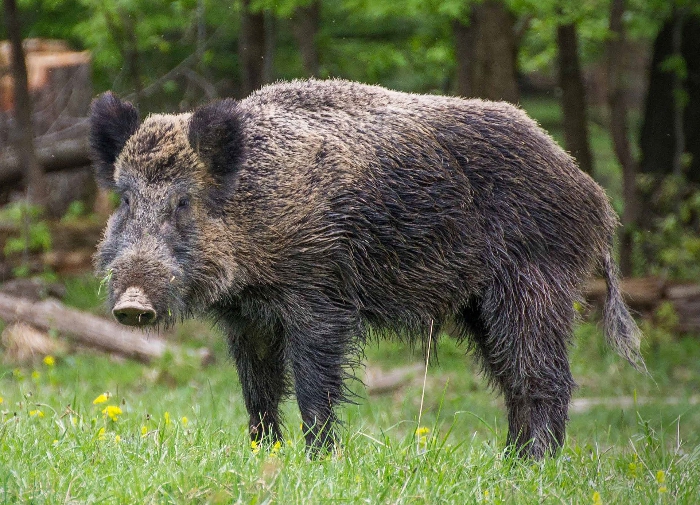Scientific name: Sus scrofa
Family: Suidae
Appearance: Wild Boar are dark-coloured with an abundance of bristly hair that can vary in colour from black to light brown. The piglets are born with brown and white/yellow stripes leading to them being called ‘humbugs’. They lose their stripes after about 3-4 months when they develop a reddish-brown coat.
Size: Body length 0.9-1.8 m; Height at shoulder 55-110 cm; Weight 100-175 kg (male), 80-120 kg (female).
Natural history: Wild Boar although native to Britain were hunted to extinction in the Middle Ages. The current extant population is made up of a mixture of animals that either escaped, or were deliberately released, from Wild Boar farms in the past 40 years. Still confined to discrete areas of the country such as the Forest of Dean in Gloucestershire and the Sussex Weald, they inhabit woodland that provides plenty of cover. They are active throughout the year and are mainly nocturnal and crepuscular. They can cover large areas during a night’s foraging (depending on the availability of food) but will return to the same resting place during the day. Wild Boar are predominantly herbivorous eating a wide variety of nuts, seeds, fruits and crops. However, they will also take invertebrates, carrion and the eggs and chicks of birds.
Males are solitary except during the rut which begins in winter. Females (sows) and young offspring form informal groups known as ‘sounders’ which may consist of between 6 and 30 animals. The peak time for giving birth is April. A sow will leave the group at this time to construct a ‘farrowing’ nest where she will give birth to 4-6 piglets and will remain in the nest with her new offspring for between 4 and 6 days. She will then rejoin the group and the piglets will cross-suckle between other lactating sows.
Wild Boar will breed with domestic and feral pigs resulting in hybrids. Some populations may be made up of a mixture of all three.

Image by Valentin Panzirsch - File:Wildschein, Nähe Pulverstampftor.jpg, CC BY-SA 3.0 at, https://commons.wikimedia.org/w/index.php?curid=46902117

 English (United Kingdom)
English (United Kingdom)  Czech (Čeština)
Czech (Čeština)  Nederlands (nl-NL)
Nederlands (nl-NL)  Magyar
Magyar  Deutsch (Deutschland)
Deutsch (Deutschland)  Croatian (Hrvatski)
Croatian (Hrvatski)  Polski (PL)
Polski (PL)  Español (España)
Español (España)